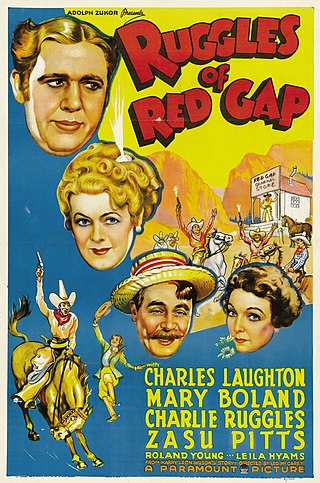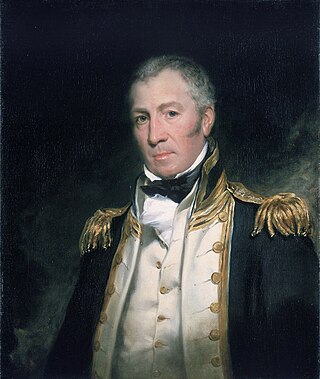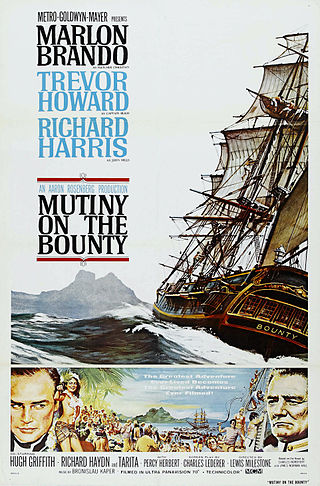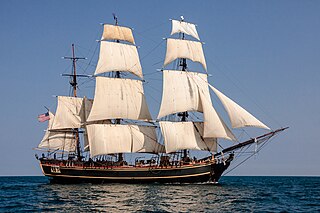
Vice-Admiral William Bligh was a British officer in the Royal Navy and a colonial administrator. He is best known for the mutiny on HMS Bounty, which occurred in 1789 when the ship was under his command. After being set adrift in Bounty's launch by the mutineers, Bligh and his loyal men all reached Timor alive, after a journey of 3,618 nautical miles. Bligh's logbooks documenting the mutiny were inscribed on the UNESCO Australian Memory of the World register on 26 February 2021.

Mutiny on the Bounty is a 1932 novel by Charles Nordhoff and James Norman Hall, based on the mutiny against Lieutenant William Bligh, commanding officer of the Bounty in 1789. It has been made into several films and a musical. It was the first of what became The Bounty Trilogy, which continues with Men Against the Sea, and concludes with Pitcairn's Island.

Ruggles of Red Gap is a 1935 American comedy western film directed by Leo McCarey and starring Charles Laughton, Mary Boland, Charlie Ruggles, and ZaSu Pitts and featuring Roland Young and Leila Hyams. It was based on the best-selling 1915 novel by Harry Leon Wilson, adapted by Humphrey Pearson, with a screenplay by Walter DeLeon and Harlan Thompson. It is the story of a newly rich American couple from the West who win a British gentleman's gentleman in a poker game.

Charles Laughton was a British actor. He was trained in London at the Royal Academy of Dramatic Art and first appeared professionally on the stage in 1926. In 1927, he was cast in a play with his future wife Elsa Lanchester, with whom he lived and worked until his death.

The mutiny on the Royal Navy vessel HMS Bounty occurred in the South Pacific Ocean on 28 April 1789. Disaffected crewmen, led by acting-Lieutenant Fletcher Christian, seized control of the ship from their captain, Lieutenant William Bligh, and set him and eighteen loyalists adrift in the ship's open launch. The mutineers variously settled on Tahiti or on Pitcairn Island. Bligh navigated more than 3,500 nautical miles in the launch to reach safety and began the process of bringing the mutineers to justice.

The Bounty is a 1984 British historical drama film directed by Roger Donaldson, starring Mel Gibson and Anthony Hopkins, and produced by Bernard Williams with Dino De Laurentiis as executive producer. It is the fifth film version of the story of the mutiny on the Bounty. The supporting cast features Laurence Olivier, Daniel Day-Lewis, Liam Neeson, Edward Fox and Neil Morrissey.
Bounty or bounties commonly refers to:

Fletcher Christian was an English sailor who led the mutiny on the Bounty in 1789, during which he seized command of the Royal Navy vessel HMS Bounty from Lieutenant William Bligh.

Peter Heywood was a British naval officer who was on board HMS Bounty during the mutiny of 28 April 1789. He was later captured in Tahiti, tried and condemned to death as a mutineer, but subsequently pardoned. He resumed his naval career and eventually retired with the rank of post-captain, after 29 years of honourable service.

Charles Edward Chauvel OBE was an Australian filmmaker, producer and screenwriter and nephew of Australian army General Sir Harry Chauvel. He is noted for writing and directing the films Forty Thousand Horsemen in 1940 and Jedda in 1955. His wife, Elsa Chauvel, was a frequent collaborator on his filmmaking projects.

Mutiny on the Bounty is a 1935 Metro-Goldwyn-Mayer drama film directed by Frank Lloyd and starring Charles Laughton and Clark Gable, based on the 1932 Charles Nordhoff and James Norman Hall novel Mutiny on the Bounty.

Mutiny on the Bounty is a 1962 American Technicolor epic historical drama film released by Metro-Goldwyn-Mayer, directed by Lewis Milestone and starring Marlon Brando, Trevor Howard, and Richard Harris. The screenplay was written by Charles Lederer, based on the novel Mutiny on the Bounty by Charles Nordhoff and James Norman Hall. Bronisław Kaper composed the score.

In the Wake of the Bounty (1933) is an Australian film directed by Charles Chauvel about the 1789 Mutiny on the Bounty. It is notable as the screen debut of Errol Flynn, playing Fletcher Christian. The film preceded MGM's more famous Mutiny on the Bounty, starring Charles Laughton and Clark Gable, by two years.

Mutineers of the Bounty, translated in English by English writer W. H. G. Kingston, is a short story by Jules Verne. The story is based on British documents about the Mutiny on the Bounty and was published in 1879 together with the novel The Begum's Fortune, as a part of the series Les Voyages Extraordinaires.

Pitcairn's Island is the third installment in the fictional trilogy by Charles Nordhoff and James Norman Hall about the mutiny aboard HMS Bounty. It is preceded by Mutiny on the "Bounty" and Men Against the Sea. The novel first appeared in The Saturday Evening Post then was published in 1934 by Little, Brown and Company. Chapters I–XV are told in the third person, and Chapters XVI–XXI are told in the first person by John Adams. The epilogue that follows is in the third person.

HMS Bounty, also known as HM Armed Vessel Bounty, was a small merchant vessel that the Royal Navy purchased in 1787 for a botanical mission. The ship was sent to the South Pacific Ocean under the command of William Bligh to acquire breadfruit plants and transport them to the West Indies to be grown as food to feed the West Indies' large population of enslaved persons. That mission was never completed owing to a 1789 mutiny led by acting lieutenant Fletcher Christian, an incident now popularly known as the Mutiny on the Bounty. The mutineers later burned Bounty while she was moored at Pitcairn Island in the Southern Pacific Ocean in 1790. An American adventurer helped land several remains of Bounty in 1957.
The Mutiny of the Bounty is a 1916 Australian-New Zealand silent film directed by Raymond Longford about the mutiny aboard HMS Bounty. It is the first known cinematic dramatisation of this story and is considered a lost film.

Charles Bernard Nordhoff was an American novelist and traveler, born in England. Nordhoff is perhaps best known for The Bounty Trilogy, three historical novels he wrote with James Norman Hall: Mutiny on the Bounty (1932), Men Against the Sea (1934) and Pitcairn's Island (1934). During World War I, he served as a driver in the Ambulance Corps as well as an aviator in both the French Air Force's Lafayette Flying Corps and the United States Army Air Service, reaching the rank of lieutenant. After the war, Nordhoff spent much of his life on the island of Tahiti, where he and Hall wrote a number of successful adventure books, many adapted for film.

The complement of HMS Bounty, the Royal Navy ship on which a historic mutiny occurred in the south Pacific on 28 April 1789, comprised 46 men on its departure from England in December 1787 and 44 at the time of the mutiny, including her commander Lieutenant William Bligh. All but two of those aboard were Royal Navy personnel; the exceptions were two civilian botanists engaged to supervise the breadfruit plants Bounty was tasked to take from Tahiti to the West Indies. Of the 44 aboard at the time of the mutiny, 19 were set adrift in the ship's launch, while 25, a mixture of mutineers and detainees, remained on board under Fletcher Christian. Bligh led his loyalists 3,500 nautical miles to safety in the open boat, and ultimately back to England. The mutineers divided—most settled on Tahiti, where they were captured by HMS Pandora in 1791 and returned to England for trial, while Christian and eight others evaded discovery on Pitcairn Island.
Charles Churchill (1759–1790) was the master at arms on board HMAV Bounty during Lieutenant William Bligh's voyage to Tahiti to transplant breadfruit to the British colonies in the West Indies. During a mutiny on the ship, Acting Lieutenant Fletcher Christian seized command of the ship from Bligh on 28 April 1789. Churchill was an active member of the mutiny, being a member of Fletcher Christian's loyalists that arrested Bligh in his cabin.
















